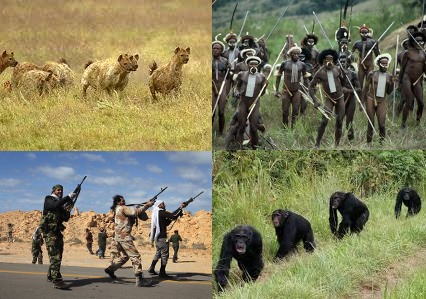| Description | Participants | Agenda | Summary | Products |
|---|
NIMBioS Investigative Workshop
Evolution and Warfare

Topic: Evolutionary approaches to the understanding of decentralized warfare
Meeting dates: September 16-18, 2015
Location: NIMBioS at the University of Tennessee, Knoxville
Organizers:
Biology: Michael L. Wilson, Univ. of Minnesota
Anthropology: Luke Glowacki, Harvard Univ.
Defense Analysis: Anna Simons, Naval Postgraduate School
Modeling: Sergey Gavrilets, Univ. of Tennessee, Knoxville
Objectives: Warfare is a widespread and arguably universal practice of human societies. While war's origins continue to be debated, warfare has occurred in most historically documented societies, from hunter-gatherers to nation-states. Its prehistoric traces can be found in fortifications, weapons, mass graves, and skeletal trauma. Given that it is a major source of mortality, warfare has potentially acted as a powerful source of selection for both biological and cultural evolution. In a reprise of the past – and in contrast to force-on-force, hierarchically organized wars among great powers – conflict today takes a number of decentralized forms, from urban gang fights to livestock raids, and from clan warfare to leaderless resistance and terrorism. Suggestive parallels exist between current patterns of warfare and those that typified subsistence-level societies. Consequently, examining psychological mechanisms that evolved under ancestral warfare conditions may shed important light on what motivates individuals during modern decentralized wars and why people resort to violence in intergroup conflicts. Given the availability of data from contemporary societies and the great damage caused by violent conflict, advancing our understanding of such conflict is both tractable and important. In this workshop, we began working toward an integrated approach to the study of warfare under decentralized or only loosely controlled conditions, combining empirical data, evolutionary theory, and mathematical models. We developed working hypotheses to answer several key questions about between-group conflict in general, and the nature of 'decentralized warfare' in particular. These hypotheses were informed by evolutionary theory using data from diverse conflict settings. Our hypotheses were articulated in a framework amenable to formal modeling that will point the way toward a multi-level predictive understanding of warfare.
Descriptive flyer (PDF)
Evolution and Warfare WordPress site
Live Stream. Presentations were available for viewing via live streaming during the workshop.
 Summary Report.
During the workshop, 35 talks varying in duration from five to 35 minutes focused on both material and immaterial causes of warfare, as well as associated collective action problems. The speakers outlined various approaches to understanding collective violence from the perspectives of primatology, anthropology, psychology, evolutionary biology, experimental economics, political science, history, and mathematical modeling. During general discussion, a list of Big Questions that seem tractable for modeling projects was developed. Future plans include a series of blog posts, a special issue of the Journal of Economic Behavior and Organization, and a NIMBioS Working Group proposal.
Summary Report.
During the workshop, 35 talks varying in duration from five to 35 minutes focused on both material and immaterial causes of warfare, as well as associated collective action problems. The speakers outlined various approaches to understanding collective violence from the perspectives of primatology, anthropology, psychology, evolutionary biology, experimental economics, political science, history, and mathematical modeling. During general discussion, a list of Big Questions that seem tractable for modeling projects was developed. Future plans include a series of blog posts, a special issue of the Journal of Economic Behavior and Organization, and a NIMBioS Working Group proposal.
Products
Publications
- Böhm R, Rusch H, Baron J .2018. The Psychology of Intergroup Conflict: A Review of theories and measures. Journal of Economic Behavior and Organization, in press. doi: 10.1016/j.jebo.2018.01.020
- Doğan G, Glowacki L, Rusch H. 2018. Spoils division rules shape aggression between natural groups. Nature Human Behaviour 2:322–326 Online]
- Glowacki L, Wilson ML, Wrangham RW. 2018. The evolutionary anthropology of war. Journal of Economic Behavior and Organization. [Online]
- Kimbrough EO, Laughren K, Sheremeta R. 2018. War and conflict in economics: Theories, applications, and recent trends. Journal of Economic Behavior and Organization in press. [Online]
- Mesterton-Gibbons M, Dai Y, Goubault M. 2016. Modeling the evolution of winner and loser effects: A survey and prospectus. Mathematical Biosciences, 274(2016): 33-44. [Online]
- Perry L, Shrestha MD, Vose MD, Gavrilet S. 2018. Collective action problem in heterogeneous groups with punishment and foresight. Journal of Statistical Physics 172(1):293–312. [Online]
- Turchin P, Gavrilets S, Goldstone JA. 2017. Linking "micro" to "macro" models of state breakdown to improve methods for political forecasting. Cliodynamics: The Journal of Quantitative History and Cultural Evolution 8:159-181. [Online]
- Wiessner P. 2016. The rift between science and humanism: What's data got to do with it? Current Anthropology 57(S13): S154-S166. [Online]
NIMBioS Investigative Workshops focus on broad topics or a set of related topics, summarizing/synthesizing the state of the art and identifying future directions. Workshops have up to 35 participants. Organizers and key invited researchers make up half the participants; the remaining participants are filled through open application from the scientific community. Open applicants selected to attend are notified by NIMBioS within two weeks of the application deadline. Investigative Workshops have the potential for leading to one or more future Working Groups. Individuals with a strong interest in the topic, including post-docs and graduate students, are encouraged to apply. If needed, NIMBioS can provide support (travel, meals, lodging) for Workshop attendees, whether from a non-profit or for-profit organization.
A goal of NIMBioS is to enhance the cadre of researchers capable of interdisciplinary efforts across mathematics and biology. As part of this goal, NIMBioS is committed to promoting diversity in all its activities. Diversity is considered in all its aspects, social and scientific, including gender, ethnicity, scientific field, career stage, geography and type of home institution. Questions regarding diversity issues should be directed to diversity@nimbios.org. You can read more about our Diversity Plan on our NIMBioS Policies web page. The NIMBioS building is fully handicapped accessible.
NIMBioS
1122 Volunteer Blvd., Suite 106
University of Tennessee
Knoxville,
TN 37996-3410
PH: (865) 974-9334
FAX: (865) 974-9461
Contact NIMBioS



